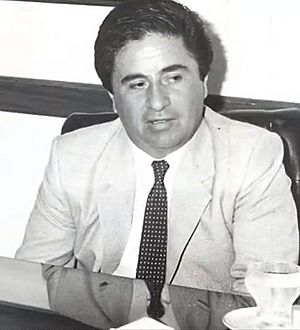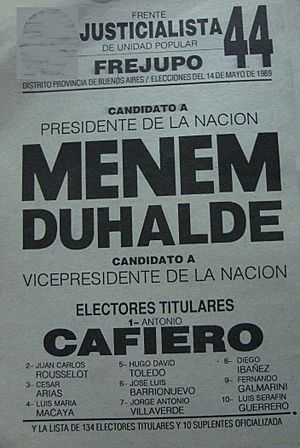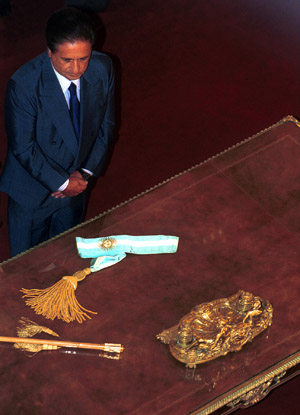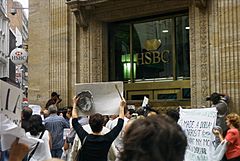Eduardo Duhalde facts for kids
Quick facts for kids
Eduardo Duhalde
|
|
|---|---|

Duhalde during Javier Milei's inauguration, 2023
|
|
| 54th President of Argentina | |
| Interim 2 January 2002 – 25 May 2003 |
|
| Vice President | None |
| Preceded by | Adolfo Rodríguez Saá (interim) |
| Succeeded by | Néstor Kirchner |
| National Senator | |
| In office 11 December 2001 – 2 January 2002 |
|
| Constituency | Buenos Aires |
| Governor of Buenos Aires | |
| In office 10 December 1991 – 10 December 1999 |
|
| Vice Governor | Rafael Romá |
| Preceded by | Antonio Cafiero |
| Succeeded by | Carlos Ruckauf |
| 30th Vice President of Argentina | |
| In office 8 July 1989 – 10 December 1991 |
|
| President | Carlos Menem |
| Preceded by | Víctor Hipolito Martínez |
| Succeeded by | Carlos Ruckauf |
| Member of the Constitutional Convention | |
| In office 1 May 1994 – 22 August 1994 |
|
| National Deputy | |
| In office 10 December 1987 – 6 July 1989 |
|
| Constituency | Buenos Aires |
| Mayor of Lomas de Zamora | |
| In office 11 December 1983 – 10 December 1987 |
|
| Preceded by | Military Junta |
| Succeeded by | Hugo Toledo |
| In office 8 August 1974 – 24 March 1976 |
|
| Preceded by | Pedro Pablo Turner |
| Succeeded by | Military Junta |
| Personal details | |
| Born |
Eduardo Alberto Duhalde
5 October 1941 Lomas de Zamora, Greater Buenos Aires, Argentina |
| Political party | Justicialist Party |
| Spouse | Hilda Beatriz González |
| Alma mater | University of Buenos Aires |
| Signature | |
Eduardo Alberto Duhalde (born October 5, 1941) is an Argentine politician. He served as the interim, or temporary, President of Argentina from January 2002 to May 2003. Before that, he was the Vice President of Argentina and the Governor of Buenos Aires.
Duhalde was born in Lomas de Zamora, a city near Buenos Aires. He was first elected as a local lawmaker and became the mayor of his city in 1973. He lost his job during the 1976 Argentine coup d'état, but was elected mayor again when Argentina returned to democracy in 1983.
In 1989, he became the vice president under President Carlos Menem. Duhalde later left that role to become the governor of Buenos Aires Province in 1991, and he was re-elected in 1995.
He ran for president in 1999 but lost to Fernando de la Rúa. In 2001, President de la Rúa resigned during major protests. The Argentine Congress then chose Adolfo Rodríguez Saá as the new president, but he also resigned after just one week. Congress then appointed Duhalde as president.
During his time as president, Duhalde made big changes to the economy. A major change was a devaluation of the Argentine peso, which helped the country's economy slowly recover. He supported Néstor Kirchner in the next election, who became president. In later years, Duhalde and Kirchner had political disagreements. Duhalde is now mostly retired from politics.
Contents
Early Life and Career
Eduardo Alberto Duhalde was born in Lomas de Zamora, part of the Greater Buenos Aires area. He became a lawyer in 1970. A year later, he was elected to his city's legislature and became its leader. He was a member of the Justicialist Party (PJ).
In 1973, he was appointed mayor of Lomas de Zamora. He was removed from office during the 1976 Argentine coup d'état. For the next few years, he worked in real estate.
When democracy returned to Argentina in 1983, Duhalde ran for mayor of Lomas de Zamora again and won a very close election. During this time, he showed his support for the new democracy by refusing to help with a possible military coup against President Raúl Alfonsín. In 1987, he was elected as a national deputy to the Argentine Chamber of Deputies.
Vice President and Governor
In 1989, Carlos Menem won the Justicialist Party's primary election to run for president, and he chose Duhalde to be his vice president. They won the general election. However, Duhalde preferred managing a government directly rather than working in the legislature.
President Menem suggested he run for governor of the large and important Buenos Aires Province. Duhalde agreed and was elected governor in 1991.
Duhalde hoped to run for president in 1995, but Menem changed the Argentine Constitution so he could run for a second term. Duhalde then changed the provincial constitution so he could be re-elected as governor. Both Menem and Duhalde were re-elected in 1995.
After the election, Duhalde began to criticize Menem's policies. He wanted the government to follow more traditional Peronist ideas. This led to a strong rivalry between the two leaders. Duhalde ran for president in 1999 but lost to Fernando de la Rúa.
Becoming President of Argentina
President de la Rúa's government faced a severe economic crisis, which led to the December 2001 riots. De la Rúa resigned, and since his vice president had already quit, Congress had to choose a new president.
First, they chose Adolfo Rodríguez Saá, the governor of San Luis Province. But he resigned after only a week because he did not have enough support.
Congress met again to pick another president. The main candidates were Duhalde and two other governors. Former president Menem tried to stop Duhalde from being chosen. However, Duhalde had the support of many powerful governors and former president Raúl Alfonsín's political party. On January 2, 2002, Congress appointed Duhalde as the interim president. He was chosen to finish the rest of de la Rúa's term.
Economic Policies
When Duhalde took office, Argentina was in a deep economic crisis. One of the main causes was the convertibility plan, which had fixed the value of the Argentine peso to the US dollar (one peso equaled one dollar). Duhalde announced he would end this plan.
His government devalued the peso, meaning its value dropped a lot compared to the dollar. At one point, it took three pesos to equal one dollar. This made Argentine products cheaper for other countries to buy, which helped businesses and created jobs. But it also made things more expensive for people living in Argentina.
The government also had to deal with the corralito, a policy from the previous government that stopped people from taking money out of their bank accounts. Duhalde's government worked to solve this problem and slowly stabilize the economy.
In April 2002, Duhalde appointed Roberto Lavagna as his minister of economy. Lavagna was successful in controlling prices and helping the economy to start growing again. The price of soybeans, a major Argentine export, also went up, which helped the country's recovery.
Domestic Policies
Duhalde's main political goal was to prevent his rival, Carlos Menem, from winning the next presidential election in 2003. He looked for a candidate who could defeat Menem.
After a violent protest forced Duhalde to call for elections six months early, he chose Néstor Kirchner, the governor of Santa Cruz Province, to be his candidate. Kirchner was not well-known at the time. Duhalde believed that while many people might vote for Menem, even more people would vote against him in a final runoff election.
For the 2003 election, the rules were changed so that Menem, Kirchner, and another Peronist candidate could all run against each other directly. Menem won the most votes in the first round, but he was not popular enough to win a second round. He decided to drop out of the race, making Néstor Kirchner the new president.
Foreign Policies
Duhalde led Argentina at a time when the United States was focused on the War on Terror after the September 11 attacks. He tried to balance Argentina's relationship with the U.S. He did not send troops to Afghanistan or Iraq but did offer to send peacekeeping forces.
His government also had a disagreement with Spain. After the peso was devalued, Spanish companies that provided services in Argentina wanted to raise their prices to make up for their losses. Duhalde's government refused, saying that the Argentine people could not afford higher prices. Despite this, the leaders of both countries remained on good terms.
Later Years and Personal Life
After Néstor Kirchner became president in 2003, he and Duhalde grew apart politically. Their rivalry became clear in the 2005 elections, when Duhalde's wife, Hilda González de Duhalde, ran for senator against Kirchner's wife, Cristina Fernández de Kirchner. Cristina Kirchner won the election.
In 2009, Duhalde announced he would run for president again in the 2011 elections. He ran on the Unión Popular ticket but received less than 6% of the vote.
Duhalde is married to Hilda "Chiche" González, and they have five children. Before his political career, he worked as a pool lifeguard. He now lives in a country house in San Vicente, Buenos Aires. Since his defeat in the 2011 election, he has been mostly retired from politics. In 2013, he and his old rival Carlos Menem met and made peace.
Documentary
- A 2024 documentary film, Jorge Batlle: entre el cielo y el infierno, shows a diplomatic event that happened with Uruguay during Duhalde's presidency.
See also
 In Spanish: Eduardo Duhalde para niños
In Spanish: Eduardo Duhalde para niños






